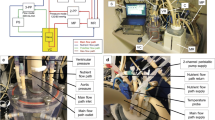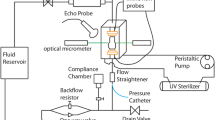Abstract
The drawbacks of state-of-the-art heart valve prostheses lead researchers to explore the prospect of using tissue-engineered constructs as possible valve substitutes. It is widely accepted that the mechanical properties of the construct are improved with mechanical stimulation during in vitro growth. We designed a new dynamic bioreactor with the perspective of using decellularized valve homografts as scaffolds in order to produce tissue-engineered valve substitutes. The design guidelines were (a) compatibility with the procedures for the treatment of homografts; (b) delivery of finely controlled pulsatile pressure loads, which induce strain stimuli that may drive cells toward repopulation of and integration with the natural scaffold; and (c) monitoring the construct’s biomechanical status through a comprehensive index, i.e., its compliance. The handling needs during the set-up of the homograft and the use of the bioreactor were minimized. The bioreactor and its automated control system underwent tests with a compliant phantom valve. The estimated compliances are in good agreement with the measured ones. Tests were also carried out with porcine aortic samples in order to assess the hydrodynamic and biomechanical reliability. In the future, monitoring the construct’s compliance might represent a key factor in controlling the recellularization of the valve homografts, which provides awareness of the construct’s biomechanical status by real-time, non-destructive, and non-invasive means.









Similar content being viewed by others
References
Barron, V., E. Lyons, C. Stenson-Cox, P. E. McHugh, and A. Pandit. Bioreactors for cardiovascular cell and tissue growth: a review. Ann. Biomed. Eng. 31:1017–1030, 2003.
Brody, S., and A. Pandit. Approaches to heart valve tissue engineering scaffold design. J. Biomed. Mater. Res. B Appl. Biomater. 83(1):16–43, 2007.
Dohmen, P. M., F. da Costa, S. Yoshi, S. V. Lopes, F. P. da Souza, R. Vilani, A. F. Wouk, M. da Costa, and W. Konertz. Histological evaluation of tissue-engineered heart valves implanted in the juvenile sheep model: is there a need for in vitro seeding? J. Heart Valve Dis. 15:823–829, 2006.
Engelmayr, Jr., G. C., D. K. Hildebrand, F. W. Sutherland, J. E. Mayer, Jr., and M. S. Sacks. A novel bioreactor for the dynamic flexural stimulation of tissue engineered heart valve biomaterials. Biomaterials 24:2523–2532, 2003.
Engelmayr, Jr., G. C., E. Rabkin, F. W. Sutherland, F. J. Schoen, J. E. Mayer, Jr., and M. S. Sacks. The independent role of cyclic flexure in the early in vitro development of an engineered heart valve tissue. Biomaterials 26:175–187, 2005.
Engelmayr, Jr., G. C., V. L. Sales, J. E. Mayer, Jr., and M. S. Sacks. Cyclic flexure and laminar flow synergistically accelerate mesenchymal stem cell-mediated engineered tissue formation: implications for engineered heart valve tissues. Biomaterials 27:6083–6095, 2006.
Flanagan, T. C., C. Cornelissen, S. Koch, B. Tschoeke, J. S. Sachweh, T. Schmitz-Rode, and S. Jockenhoevel. The in vitro development of autologous fibrin-based tissue-engineered heart valves through optimised dynamic conditioning. Biomaterials 28:3388–3397, 2007.
Hildebrand, D. K., Z. J. Wu, J. E. Mayer, Jr., and M. S. Sacks. Design and hydrodynamic evaluation of a novel pulsatile bioreactor for biologically active heart valves. Ann. Biomed. Eng. 32:1039–1049, 2004.
Hoerstrup, S. P., A. Kadner, S. Melnitchouk, A. Trojan, K. Eid, J. Tracy, R. Sodian, J. F. Visjager, S. A. Kolb, J. Grunenfelder, G. Zund, and M. I. Turina. Tissue engineering of functional trileaflet heart valves from human marrow stromal cells. Circulation 24:I143–I150, 2002.
Hoerstrup, S. P., R. Sodian, S. Daebritz, J. Wang, E. A. Bacha, D. P. Martin, A. M. Moran, K. J. Guleserian, J. S. Sperling, S. Kaushal, J. P. Vacanti, F. J. Schoen, and J. E. Mayer, Jr. Functional living trileaflet heart valves grown in vitro. Circulation 7:III44–III49, 2000.
Hopkins, R. A. Tissue engineering of heart valves: decellularized valve scaffolds. Circulation 111:2712–2714, 2005.
Johnson, M. A., and M. H. Moradi. PID Control New Identification and Design Methods, 2nd edn. London: Springer-Verlag, pp. 103–107, 2005
Karim, N., K. Golz, and A. Bader. The cardiovascular tissue-reactor: a novel device for the engineering of heart valves. Artif. Organs. 30:809–814, 2006.
Lichtenberg, A., I. Tudorache, S. Cebotari, S. Ringes-Lichtenberg, K. Sturz, G. Hoeffler, C. Hurscheler, G. Brandes, A. Hilfiker, and A. Haverich. In vitro re-endothelialization of detergent decellularized heart valves under simulated physiological dynamic conditions. Biomaterials 27:4221–4229, 2006.
Mendelson, K., and F. J. Schoen. Heart valve tissue engineering: concepts, approaches, progress, and challenges. Ann. Biomed. Eng. 34:1799–1819, 2006.
Merryman, W. D., I. Youn, H. D. Lukoff, P. M. Krueger, F. Guilak, R. A. Hopkins, and M. S. Sacks. Correlation between heart valve interstitial cell stiffness and transvalvular pressure: implications for collagen biosynthesis. Am. J. Physiol. Heart Circ. Physiol. 290(1):H224–H231, 2006.
Miller, D. V., W. D. Edwards, and K. J. Zehr. Endothelial and smooth muscle cell populations in a decellularized cryopreserved aortic homograft (SynerGraft) 2 years after implantation. J. Thorac. Cardiovasc. Surg. 132(1):175–176, 2006.
Mol, A., C. V. Bouten, G. Zund, C. I. Gunter, J. F. Visjager, M. I. Turina, F. P. Baaijens, and S. P. Hoerstrup. The relevance of large strains in functional tissue engineering of heart valves. Thorac. Cardiovasc. Surg. 51:78–83, 2003.
Mol, A., N. J. Driessen, M. C. Rutten, S. P. Hoerstrup, C. V. Bouten, and F. P. Baaijens. Tissue engineering of human heart valve leaflets: a novel bioreactor for a strain-based conditioning approach. Ann. Biomed. Eng. 33:1778–1788, 2005.
Mol, A., M. C. Rutten, N. J. Driessen, C. V. Bouten, G. Zünd, F. P. Baaijens, and S. P. Hoerstrup. Autologous human tissue-engineered heart valves: prospects for systemic application. Circulation 4:I152–I158, 2006.
Morsi, Y. S., W. W. Yang, A. Owida, and C. S. Wong. Development of a novel pulsatile bioreactor for tissue culture. J. Artif. Organs. 10:109–114, 2007.
Ruel, J., and G. Lachance. A new bioreactor for the development of tissue-engineered heart valves. Ann. Biomed. Eng. 37(4):674–681, 2009.
Schenke-Layland, K., F. Opitz, M. Gross, C. Döring, K. J. Halbhuber, F. Schirrmeister, T. Wahlers, and U. A. Stock. Complete dynamic repopulation of decellularized heart valves by application of defined physical signals—an in vitro study. Cardiovasc. Res. 60:497–509, 2003.
Schmidt, D., A. Mol, C. Breymann, J. Achermann, B. Odermatt, M. Gossi, S. Neuenschwander, R. Pretre, M. Genoni, G. Zund, and S. P. Hoerstrup. Living autologous heart valves engineered from human prenatally harvested progenitors. Circulation 4:I125–I131, 2006.
Vesely, I. Heart valve tissue engineering. Circ. Res. 14:743–755, 2005.
Vilendrer, K., et al. Bioreactor with plurality of chambers for conditioning intravascular tissue engineered medical products. US patent application 2003/0199083 A1.
Webb, A. R., B. D. Macrie, A. S. Ray, J. E. Russo, A. M. Siegel, M. R. Glucksberg, and A. A. Guillermo. In vitro characterization of a compliant biodegradable scaffold with a novel bioreactor system. Ann. Biomed. Eng. 35(8):1357–1367, 2009.
Zilla, P., J. Brink, P. Human, and D. Bezuidenhout. Prosthetic heart valves: catering for the few. Biomaterials 29:385–406, 2008.
Acknowledgments
The authors are grateful to Prof. Nicola Volpi from the University of Modena and Reggio Emilia for fruitful discussions. This work was partly supported by the Italian Ministry of Health, RC2005.
Author information
Authors and Affiliations
Corresponding author
Rights and permissions
About this article
Cite this article
Vismara, R., Soncini, M., Talò, G. et al. A Bioreactor with Compliance Monitoring for Heart Valve Grafts. Ann Biomed Eng 38, 100–108 (2010). https://doi.org/10.1007/s10439-009-9803-1
Received:
Accepted:
Published:
Issue Date:
DOI: https://doi.org/10.1007/s10439-009-9803-1




